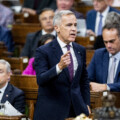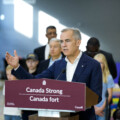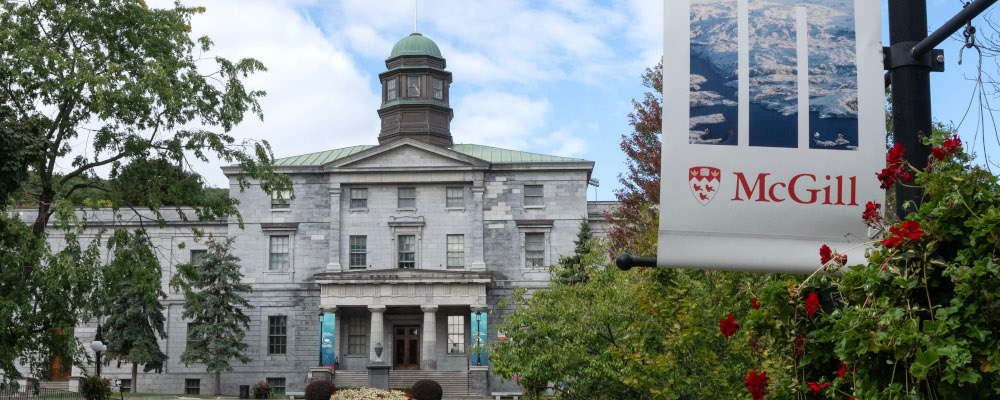This week, York University suspended three employees—including Lesley J. Wood, a former chair of its sociology department,—in light of criminal charges in connection to hate-motivated vandalism at a Toronto Indigo store.
It’s not the first time that York University has been in the media since Hamas’ terrorist attacks against Israel on October 7. Last month its student unions issued a statement of solidarity that described the attacks as “necessary and justified.” The university’s administration eventually condemned the statement and threatened to revoke the student unions’ status in the face of growing political pressure from the Ontario government.
Although York University has arguably been home to a more radical response to the Israel-Hamas war than many of its peers, it has certainly faced stiff competition. Students and faculty members at universities across the country have been at the centre of some of the most extreme and offensive expressions of support for Palestine including what has often bordered the increasingly invisible line between anti-Zionism and antisemitism. This has led to growing criticism of Canada’s university sector and emerging questions about the role of democratic accountability for institutions that remain dependent on public funding.
In this context, University of British Columbia law professor Camden Hutchison has published a thoughtful essay at The Hub that raises alarms about creeping political interference in universities that, in his view, represents a threat to academic freedom. Even though he characterizes pro-Palestinian activism as “simplistic”, “tendentious”, and even “morally repugnant”, he argues that, as a matter of principle, it’s wrong for universities or the government to limit non-violent ideas or speech on campus. As he puts it: “I have viewed the policing of Pro-Palestine expression with concern…To regulate expression on sensitive or controversial topics is to undermine the purpose of the university itself.”
Hutchison’s principled defence of academic freedom is well-taken. It’s a useful rejoinder to those—including some conservatives—who inconsistently lament a lack of free speech on campus in some circumstances and then call on politicians to intervene in response to speech that they don’t like. The application of a political lens to faculty hiring or the selection of research topics would represent a threat to the truth-seeking mission of universities. It would necessarily politicize knowledge, impede the development of new ideas, and ultimately undermine intellectual progress itself.
Yet there’s a third option between politicians excessively reaching into universities on one hand, and taxpayers continuing to subsidize counterproductive radicalism on the other hand. Canadian governments should start to ween universities off subsidized tuition rates with the goal of closing the gap between the true cost and market price of post-secondary education.
Requiring students to assume the full cost of their university education would have several upsides, including: delivering on egalitarian goals about university access using far more efficient policy means, requiring students and universities to internalize the costs of their educational and research choices, and ultimately solving for the democratic tension inherent to notions of academic freedom in a publicly-funded model.
Why and how much do taxpayers subsidize Canadian universities?
Before considering the arguments in favour of lowering and even eliminating subsidized tuition rates, it’s worth a brief primer on how and to what extent universities in Canada relies on public subsidies.
The case for public support for post-secondary education is primarily rooted in what economists refer to as “positive externalities.” The basic idea is that the benefits of university education aren’t merely internalized by students or professors. They’re believed to spill over into the broader society in the form of a more educated and productive workforce, scientific and technological breakthroughs, and even a more informed and better-functioning democracy. As a result of these spillovers, government subsidies partly collectivize the costs for students attending universities and for the administrators who operate them.
Public subsidies come in different forms including regulated tuition rates, general operating funding, student grants and loans, and research funding. Government funding represents roughly half of total university revenues. Tuition payments are responsible for about one-third.
Statistics Canada data show that, in constant dollars to adjust for inflation, average tuition rates for Canadian students have generally been flat or even falling over the past five years. This is due in part to a mandated 10-percent tuition reduction in 2019-20 and a subsequent four-year freeze in the Province of Ontario.
The average undergraduate tuition rate this year nationwide is $7,076. The highest rate was in Nova Scotia at $9,575. The lowest was in Quebec at $3,461. The level of public subsidy embedded in tuition rates not only varies across provinces but it also differs across fields of study.
It can be difficult therefore to pin down precisely the gap between the actual cost per student and the subsidized price. The Quebec government’s recent announcement to raise out-of-province tuition rates from $8,992 to approximately $17,000 per year provides a rough sense. The government claims that the previous tuition rate amounted to a $110 million annual subsidy to non-Quebec students. These figures are consistent with a new Ontario government report that estimates the per-student operating subsidy for the province’s universities in 2021 was $8,350. Even if one believes that these figures are somewhat overstated, they signal directionally the extent to which taxpayers are subsidizing tuition rates for domestic students.
Why revisit tuition subsidies?
Last month, a “blue-ribbon panel” appointed by the Ontario government to provide recommendations on improving the financial sustainability of the province’s post-secondary system released its report. The report contained a series of recommendations including boosting public funding and permitting universities and colleges to gradually raise their tuition rates. Yet it also observed the following:
…the panel noted that some of the submissions received argued for an unfettered approach to setting tuition fees that would be reflective of market demand and competition for high quality students. This approach would have to be mitigated by a far greater investment in institutional student assistance. For the most part, the panel elected to err on the side of caution.
There’s a good case, however, that moving to a more market-based tuition model is actually a sensible policy step. There are various arguments in its favour—including three outlined below: (1) subsidized tuition rates are regressive, (2) the positive externalities of university education and research are overstated, and (3) moving to a market-based model strengthens the principle of academic freedom.
Subsidized tuition rates are an inefficient means of achieving the egalitarian goal of removing financial barriers to low-income students attending university. As economist Stephen Gordon has observed, the current model of subsidized tuition rates is highly regressive—it disproportionately benefits students from high-income households for whom tuition rates aren’t a barrier to accessing university education. It would be a far more efficient and equitable use of scarce public resources to permit tuition rates to rise to levels commensurate with a university’s actual per-student costs and then target low-income students with a mix of government and institutional grants to reduce their market price. The net effect would be to rationalize public funding for universities along more progressive lines.
The positive externalities of higher education are overstated on two grounds. First, the financial benefits for individuals of attending university greatly exceed the costs. Although the market returns for university education vary across fields of study and may even be stagnating overall, they’re still significant. The median annual earnings for someone with a bachelor’s degree or higher in Canada are roughly 50 percent more than for someone with only a high school diploma. There’s even new Statistics Canada research that shows there was a huge educational premium for how people fared during the COVID-19 pandemic. The key point here is that university graduates internalize a lot of individual benefits and therefore there’s a strong case that they ought to assume responsibility for most of the costs too.
Second (and relatedly), it’s far from obvious these days that universities are producing broad spillovers that justify the current levels of public subsidization. It’s not to say that there’s nothing productive occurring on university campuses. But there are reasonable questions to ask in light of what we’ve witnessed in the past several weeks.
Take Professor Lesley J. Wood for instance. She received a base salary of more than $160,000 in 2021 which amounted to roughly 2.4 times Canada’s median household income. She also presumably receives generous health and pension benefits as well as publicly-supported research funding for her work on left-wing protest movements such as the 2014 book on protest policing which is described as “an activist’s guide to understanding the militarization of the policing of protests.”
One may even agree with the book’s conclusion that “neoliberal transformations of political and economic systems are militarizing the policing of protest” and still have doubts that her scholarship is producing positive externalities that warrant public subsidies. It’s hard to argue for instance that such research contributes to broad-based knowledge or progress. Instead, it’s a highly debatable and doctrinaire left-wing argument that Woods and others are free to make, but it’s not clear why the rest of us should subsidize it.

The same case extends to a lot of current academic research. It seems clear in recent weeks for instance that parts of critical theory scholarship have contributed to an intellectual paradigm about the so-called “oppressed and oppressors” that not only fails to produce positive externalities but arguably creates negative ones in the form of radical ideologies that can lead to social disorder, criminality, and even acts of terrorism. Universities should be free to offer such courses and programs and students should similarly be free to pursue them. It’s just that they should probably be responsible for figuring out how to pay for them themselves.
As I’ve previously written, university scholars don’t have a positive right to publicly-subsidized employment or research and universities don’t have a positive right to their current levels of public funding. There’s nothing sacrosanct about the current funding model. It’s evolved over time as an expression of politics.
Which brings us to the inherent tensions of democratic accountability in a publicly-subsidized university model. As long as university students benefit from subsidized tuition rates and their professors benefit from subsidized employment and research, there’s a case that taxpayers ought to have a voice in what’s produced in their name using their tax dollars. The mechanism for expressing such a voice in democratic societies is politics. Yet, as outlined earlier, one can accept that there are legitimate problems with subjecting university teaching and academic research to majoritarian politics.
If Wood taught at a privately-funded university and wanted to study how left-wing protestors can evade law enforcement, one might think she’s an ideological lunatic, but, as long as she wasn’t breaking the law, our personal opinions wouldn’t matter. Students would be free to self-select into her programs and courses and taxpayers for which they’d fully cover the costs and in turn taxpayers wouldn’t be expected to fund her scholarship.
That strikes me as the best means to ultimately resolving the problem that Hutchison rightly identifies in his article for The Hub. As long as taxpayers are footing a considerable share of the bill of post-secondary education, there will be these inherent tensions between the principles of democracy accountability and academic freedom. The solution, in my mind, is to extract, as much as possible, the government from the business of ideas and scholarship. That means putting an end to subsidized tuition.
Recommended for You

Like the Blue Jays, Carney’s first budget falls just short

The UCP empowered Albertans to have their say. Now it may be coming back to bite them

‘This is significant’: Hub Politics on Carney’s disappointing budget being overshadowed by a dramatic floor crossing

‘Bet against the president winning’: Could an American Supreme Court ruling save Canadian trade?




